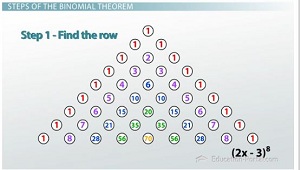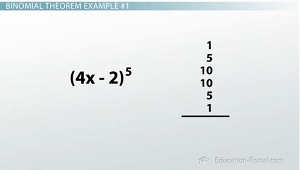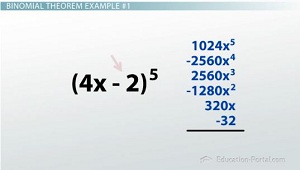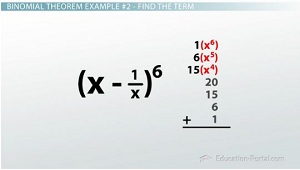Binomial Theorem Practice Problems - Quiz
Choose your answer and write the correct one down. Then click HERE for the answers to this quiz.
NOTE: The transcript from the video is listed below the quiz for your reference.
1. What does step 2 of the Binomial Theorem tell us to do with the first term of the binomial?
- Write decreasing powers of the second term in the binomial
- Write decreasing powers of the first term in the binomial
- Write increasing powers of the second term in the binomial
- Find the corresponding row of Pascal's triangle
- Write increasing powers of the first term in the binomial
The binomial theorem can be a really helpful shortcut, but it can also be really confusing. Brush up on your skills with this useful rule in these practice problems!
Steps of the Binomial Theorem
Although the binomial theorem is the shortcut for raising a binomial to a power, it doesn't always feel that way. If you've found yourself getting confused while trying to use it, it can help to break it up into three steps.
 |
Step 1: Find the corresponding row of Pascal's Triangle for your problem.
Step 2: Write decreasing powers of the first term, beginning with as many as we have in the problem.
Step 3: Write increasing powers of the second term, beginning with none of them.
I've found that if I try to do these steps all at once, or in different orders, I easily forget where I was or what I'd already done. Now I always stick to this order and write out a skeleton for my problem to keep track of which steps I've already done and which I still need to do.
Binomial Theorem Example #1
 |
So let's go ahead and try that process with an example; maybe this example tells us to use the binomial theorem to expand (4x-2)^5.
Okay, step 1: which row of Pascal's Triangle do we need?
Well, let's jot down the triangle on the side of our paper here, remembering to add the two entries above to get the one below. You can either remember that we need to get the 6th row down (because the first row is the zero row), or you can just keep going until you see a 5 next to one of the 1s. Either way, we end up with the entries 1, 5, 10, 10, 5, 1.
I now go back over to the problem and copy these numbers down. This is what I call the 'skeleton' of the problem. It helps me keep my work organized and also prevents me from making a silly mistake.
Step 2 is to begin filling in the skeleton with decreasing powers of the first term. Because the binomial was originally being raised to the 5th power, I begin with a 4x^5. The next term gets a 4x^4, the next one a 4x^3, then 4x^2, then 4x^1, then finally 4x^0, or basically no 4xs at all.
Step 3 is to do the opposite with the second term. We begin with zero -2s, but then gradually increase the number of them. Our next term has -2^1, then -2^2, then to the 3rd, to the 4th, and finally the last term has -2^5.
At this point our expression is essentially complete, but to be fully finished, we must follow the order of operations and first evaluate the exponents, then multiply together the resulting numbers in each term just to kind of have it simplified out.
 |
The first term really only has one power to worry about, (4x)^5. 4^5 = 1,024 and x^5 is just x^5, so (4x)^5 is just 1,024x^5.
We again only have one power to worry about in the second term, so we evaluate it similarly and change (5)((4x)^4)(-2) to (5)(256x^4)(-2).
Our third term has two powers to be careful with, but the process is still basically the same. (4x)^3 turns into 64x^3, while -2^2 is 4. Continuing this process of evaluating exponents and re-writing for the remaining three terms would make our complete expansion look like so.
Now it is simply a matter of multiplying the numbers within each term. There's nothing to multiply except 1s in the first term, so it basically stays the same and is written as 1,024x^5.
We need to multiply a few things for the second term, though. 5, 256, and -2 are all there, so we multiply those together and we end up with -2,560x^4.
Continuing to multiply and re-write will give us our final answer as this. While it may be quite a bit of work, once you get the rhythm down it's really not too bad! Notice the alternating positive and negative coefficients. This is going to happen any time you have a negative second term, because it alternates from even to odd exponents. The odd ones leave it negative, but the even ones change it back to a positive number.
Binomial Theorem Example #2 - Find the Term
 |
Let's take a look at one other practice question: What is the third term of the expansion (x-(1/x))^6? While this one will actually end up being less work, it is more abstract and might actually seem more difficult than the previous one.
Let's not let the weirdness get in the way of us doing our normal routine. First we have to figure out what the corresponding row of Pascal's Triangle is. The 6th power in the problem tells me to find the row with a 6 after the 1, and it looks like we get 1, 6, 15, 20, 15, 6, 1. So I copy those numbers onto my paper as my skeleton.
But now we should read the directions carefully and notice that it only asks for the third term, which is the one with the 15 in front of it. While it's probably a good idea to leave the rest of the skeleton there to help us stay organized, we don't have to worry about filling in the other terms, which is actually going to save us a ton of work!
I can now begin step 2 and write decreasing powers of the first term, x. If I was filling it all in, there would be x^6 in the front term, then an x^5, and then the term we're worried about has an x^4. I won't bother filling in the rest, because we're not too concerned with that, and I'll move on to step 3 - increasing powers of the second term. There'd be zero 1/xs in the first term, one of them in the second term, and the term we're concerned about has (1/x)^2.
Now we're just evaluating exponents and multiplying things together. Distributing the 2 to the 1 and the x gives me 1/(x^2) for this part of my term, then multiplying everything together gives me 15x^4/x^2 as my term. Then using the exponential properties to subtract the exponent says that the third term of my expansion would just be 15x^2.
Lesson Summary
 |
To review: Setting up the binomial theorem has three parts. First, find the corresponding row from Pascal's Triangle. Second, write decreasing powers of the first term. Third, write increasing powers of the second term.
Drawing the skeleton in first and using it to organize your work helps limit mistakes. Once the skeleton is filled in, use the order of operations to evaluate the exponents and multiply together the numbers within each term. While a lot of questions will ask for the entire expansion, some questions will only ask for one term, or maybe even just one coefficient. If that's the case, you only have to worry about one part of the expansion!